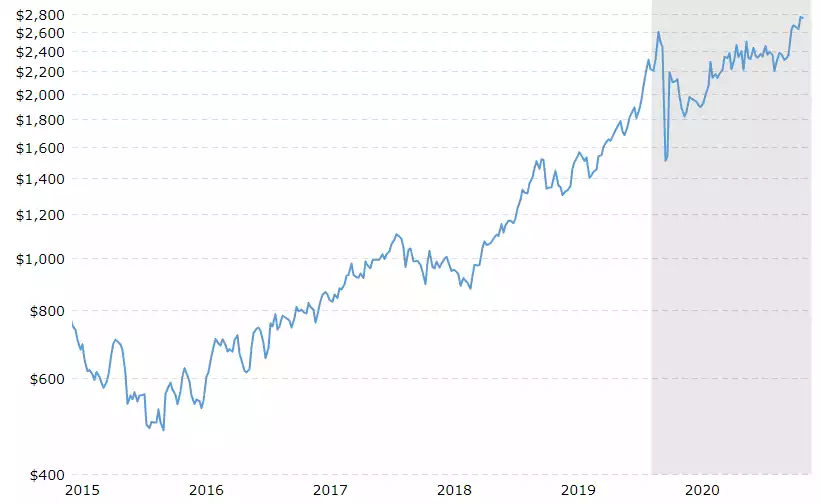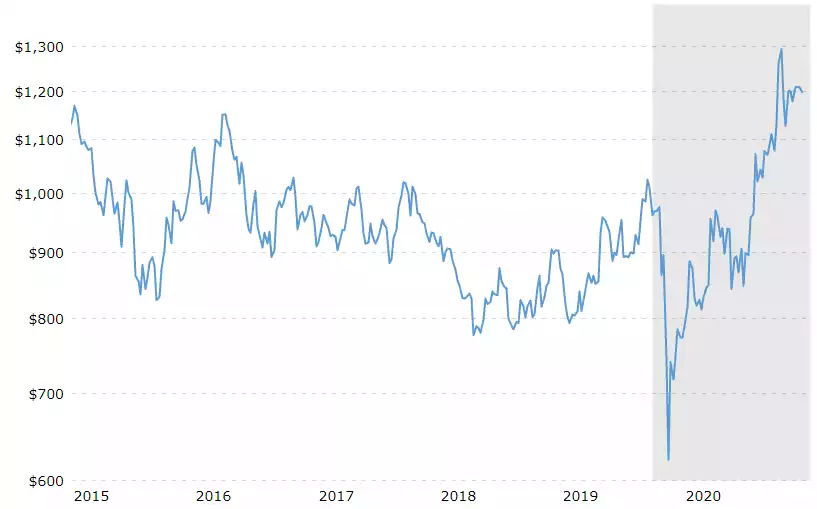Platinum – New rules may see it do a ‘palladium’
News
|
Posted 22/04/2021
|
6172
It was another strong night for precious metals last night as the dip having past narrative grows. Whilst silver was again the star of the night (up over 2.5%), platinum was very close behind as it saw further strengthening. Whilst gold has trended down since last August to find a low at the beginning of this month, platinum having had a small correction in August, has been strong since, up nearly 50% since September. The following article from the World Platinum Investment Council illustrates why there is still great potential for platinum having seen what happened with palladium since 2015.
Both PGM metals are key components for catalytic converters in vehicles. Whilst similar, palladium tends to be better for petrol engines and platinum better for diesel. As you can see in the chart below, the price of palladium has gone from around $500 to $2800 in just 5 years, a 460% increase amid growing demand and supply constraints.

Comparing charts, you can see platinum has been tracking sideways in a $200 band over the same period until breaking out last November:

As platinum currently sits at around US$1220, it is now less than half the price of palladium for which it shares similarly effective chemical properties. Palladium sits outside the Australian bullion definition and hence attracts GST. Platinum does not.
The following article outlines new (continually) tighter rules coming into effect this year putting more and more pressure on the demand for platinum. It’s a worthy read.
“This year, automotive demand for platinum is expected to grow by 25 per cent to reach almost three million ounces – 5 per cent above pre-pandemic levels. In fact, 2021 could see the highest automotive platinum demand since 2018, notwithstanding the expectation that light-duty vehicle production will be some 1.1 million units below pre-pandemic levels and heavy-duty production will fall by one percent when compared to 2020. Key to this strong demand recovery is the impact of tightening emissions legislation, especially in Europe and China, which is driving higher platinum loadings across both light and heavy-duty vehicles.
The main automotive use of platinum is in emissions control systems that reduce harmful emissions from, predominantly diesel, internal combustion engine vehicles. The term ‘loadings’ refers to the quantity of metal used in an emissions control system. Each system on a vehicle comprises one or more autocatalyst ‘bricks’, sometimes in combination with exhaust gas recirculation and liquid urea injection. All parts of the system are intimately integrated with sensors and electronic engine firing controls.
As systems have become increasingly sophisticated in response to more stringent emissions limits and the advent of on-road, rather than in-laboratory, testing, metal loadings have increased. For example, in Europe, following the 2015 ‘Dieselgate’ scandal, the increased focus on reducing oxides of nitrogen (NOx) from diesel vehicles resulted in higher urea dosing rates and more platinum per catalyst to convert nitrogen oxide to nitrogen dioxide, optimising the removal of NOx.
Underpinning the 2021 forecast for automotive platinum demand is the implementation of China VI standards, applicable to heavy-duty vehicles. Johnson Matthey expects platinum group metal loadings on trucks that meet China VI requirements, which come into force from July, to be approximately three times higher than loadings for China V, with platinum accounting for most of this increase.
PGM loadings and substitution
Rising PGM loadings heavily influence a further dynamic that is boosting automotive platinum demand growth. Platinum is increasingly being used as a substitute for the relatively more expensive palladium in gasoline emissions control systems due to the price differential between the two metals, bearing in mind that one gram of platinum provides almost the same catalytic effect as one gram of palladium.
Again, ever more stringent regulation is also playing a major part. Since January 2021 all light-duty gasoline vehicles sold in Europe and China have been required to meet new, lower emissions limits. What is more, vehicles in Europe are now subject to mandatory on-road testing as a result of the implementation of Euro 6d.
In China, under the current China 6a rules, on-road testing is not mandatory, but some manufacturers have already implemented emissions control standards that meet forthcoming China 6b rules on a voluntary basis, including on-road testing, which will be obligatory under China 6b.
The combined impact of Euro 6d and China 6 regulations has led to significantly higher palladium loadings on the gasoline vehicles produced in these regions. These higher loading requirements are exacerbating shortages in the palladium market, which in 2020 experienced its ninth consecutive deficit. This has in turn led to the price of palladium significantly overshooting the price of platinum and increasing the financial incentive to substitute, with the peak platinum to palladium discount of US$1,060 per ounce in 2019 ballooning to US$1,903 per ounce in 2020.
As a result, platinum for palladium substitution has been accelerated further, although substitution on existing vehicle models can be a slow, less economically attractive, process. Nevertheless, some industry participants now project that, by 2025, as much as 1.5 million ounces of additional platinum will be used annually to replace palladium in car and van models whose first release pre-dates the requirement to meet new emissions legislation, most likely in the North American market.
On new vehicle models, where new emissions systems have been necessary to meet lower emissions limits, substitution could well have taken place with almost no additional engineering, testing or certification costs. With around 32 million light-duty gasoline vehicles expected to be produced in China and Europe alone this year, already developed to meet Euro 6d and China 6a (and in some instances China 6b), it is possible that these regions alone will see platinum substituting over 400 koz of palladium in 2021.”